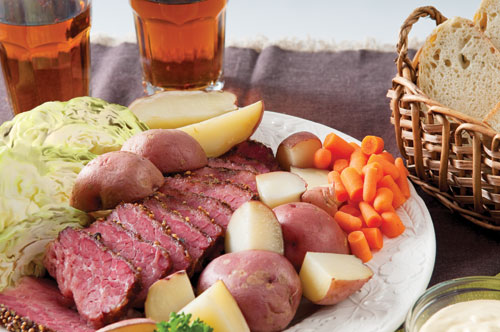FREE ST. PATRICK’S DAY HOLIDAY BONUS FOR OUR LOYAL TRIBUNE READERS …
 Chef Frank has posted his recipe, compete with tons of pro chef tips, for a traditional Corned Beef and Cabbage dinner for your St. Paddy’s day celebrations. See Recipe below
Chef Frank has posted his recipe, compete with tons of pro chef tips, for a traditional Corned Beef and Cabbage dinner for your St. Paddy’s day celebrations. See Recipe below
Corned Beef and Cabbage Recipe for Saint Patrick's Day!
CORNED BEEF has really only been served in Ireland kitchens from around the first part of the century. Before that, almost everyone used Irish bacon and cabbage. There is also a brisket roast called “salt beef” that is predominantly used, but it is not ‘corned’ beef. It was the Irish-Americans in New York City that substituted corned beef for the bacon to save money... rumored a suggestion from their Jewish neighbors. CORNED BEEF has really only been served in Ireland kitchens from around the first part of the century. Before that, almost everyone used Irish bacon and cabbage. There is also a brisket roast called “salt beef” that is predominantly used, but it is not ‘corned’ beef. It was the Irish-Americans in New York City that substituted corned beef for the bacon to save money... rumored a suggestion from their Jewish neighbors. Corned beef has nothing to do with corn. It is actually an industry term for “fine, small particle”. Hence the use of small granular Kosher salt… the beef is said to be “corned” with grains of salt. Corned beef and cabbage is a traditional American St. Patrick's Day dish. In 2009, roughly 26.1 billion pounds of beef and 2.3 billion pounds of cabbage were produced in the United States. Yes, billions… There are about 40 million Americans that claim Irish roots yet only about 4.5 million people actually live in Ireland.
Servings: 8
Ingredients
- 4 lb Beef Brisket - either long flat piece or a "tip" "point" or "triangle" cut
- Water - enough to reach 3/4 of the way up the roast in the pan
- Vegetable Oil optional
- Cabbage - Napa or Savoy
- Veggies for the pot optional - Potatoes, Onions, Carrots, Celery, Parsnips, Kohlrabi, Rutabagas and Turnips
- Bay Leaves - several
- Dry Oregano optional
- Parsley garnish
Instructions
- Brisket Basics
- Raw Corned Beef usually comes pre-prepared and oven ready. It will come in 2 basic ways: a long flat piece and a larger “tip”, “point” or “triangle” cut. These are the two parts of a whole brisket, when together it can weigh about 15 pounds! The flat pieces will cook faster but are more lean and can be tough if not cooked long and slow enough. The “points” have more fat in them and because they are thicker, can be better for sandwich slicing.
- Because these ‘high use’ muscles are so dense, long cooking times and very moist cooking procedures are needed. If the roasts are undercooked, cooked too quickly at high heat or allowed to dry out they will be tough, chewy and terrible. “Low and Slow” is the ideal method.
- Roasting Pan – Find one deep enough to hold the piece of brisket covered with water. Make sure it has a lid or you can simply use foil. Enamelware iron or iron Dutch Ovens are best. But any heavy deep roasting pan will do. No worries if you don’t have one, wait for a nice pan to go on sale, every kitchen needs one. A big ‘ol foil pan like the one you use for the Thanksgiving turkey will work just fine.
- Time to get Cooking – 300 degree oven
- Put the roast in the pan and fill up with water until it reaches about three quarters of the way up the roast. Add the small packet of seasoning (if it comes with one). Cover and bring to a boil, turn off and place it in the 300 degree oven. (Do not boil if using a foil pan, just add water, cover and place it in the oven) Set your timer and check the water level every hour. Add more as it evaporates. Each time you add water, skim the fat off first.
- I usually allow at least 1 hour for every pound of brisket. You want longer cooking times than your regular beef pot roasts. So a 4 pound roast usually takes me at least 5 hours to get to pull apart easily. You want the internal temperature to hit 160 or above... but that does not mean it’s done. You have to let it continue to cook until it is fork tender.
- For a slicing roast, lessen the cooking time so it does not pull apart easily. (great for next day sandwiches) How do you know it’s done? You’ll have to taste-test it, the best part of being a cook! Stick a fork into the roast, then gently turn to see if it pulls apart.
- Once done, remove from the cooking liquid and let it “rest” for 20 minutes before carving.
- That’s it, the core recipe.
- Browning Roasts - If you would like more flavor, add some brownness to the roasts, you can do that in your heavy iron roasting pan. (another need for those thick heavy pans) Start with a hot pan and add some vegetable oil. Gently put the roast in the pan and let it sit & sear, don’t move it around. Get a dark sear on every side then follow the recipe above.
- Alternative – you can also add (more) brownness at the end of the cooking time. When the roast is done, drain off the water and crank the oven up to 450 degrees. Once the oven is pre-heated, put the roast back in and let it get nice and dark. This happens very quickly, so set your timer for 10 minutes and keep an eye on it.
- Where’s The Cabbage? – There are two schools of thought on how to cook the cabbage. First choose the cabbage you like regular. Napa(curly and long) or Savoy (curly and round). I like them all. Wash the heads under cold running water, peel off any wilted or damaged leaves and remove the core.
- Cabbage in the Pan – Pull off the first 2-3 layers of leaves, place them in the bottom of the roasting pan, then take the head and quarter it into wedges, or cut into smaller chunks. Add the roast into the pan and pack the cabbage chunks around it. Cook the roast to the desired doneness and add your veggie choices during the last hour.
- Cabbage on the Side – Coarsely chop the cabbage into 1 ½” inch pieces and simply simmer it. It’s served on the side with butter and a little pepper. This is for those that don’t want the salty brine from the beef to saturate the cabbage, spuds and veggies. –see veggies next:
- Veggies for the pot or pan – add these tasty veggies. Potatoes, I like little red & Yukon gold potatoes, onions, carrots, celery and parsnips. Some add other root veggies like kohlrabi, rutabagas, and turnips. Cut everything into big large “rustic” chunks, all relatively the same size so they will be fully cooked at the same time. These will be your side dishes to the roast. Most people like to add them to the roasting pan juices during the last hour of cooking, this keeps them firm and full of flavor. Others add them at the beginning. ( I think they absorb too much of the salty brine and are overcooked and mushy.) While others gently boil them in water while the roast is resting. But it’s up to you, enjoy your veggies any way you like them.
- Herbs & Spices – commonly added corned beef friendly herbs and spices are black & green peppercorns, coriander seeds, a couple of allspice seeds, cloves and mustard seed. Add several bay leaves and thyme. I will sometimes add some dry oregano. As you skim off the fat while roasting, you’ll want to add more of these herbs & spices. After everything is cooked, I like to garnish with a ton of fresh chopped parsley. It adds an aromatic and earthy depth of flavor.
- Herbs & Spices Note: if you don’t have these spices, just wait for them to go on sale and stock your spice rack. The whole seed spices last much longer than a year and are great with all other beef or lamb roasts.
Notes
Chef Frank Tips
Low Sodium - If you want the corned beef to be less salty, then every hour, completely drain off all the liquid and add fresh hot water. You’ll need to add the herbs & spices from my list above.
Never let the roast dry out. If for some bizarre reason your roast is dry, you can add slices to the liquid in the bottom of the roasting pan for a few minutes. Some folks like to add a splash of the cooking liquid over the sliced beef as the plates are served.
On the Side – try different types of whole grain mustards (the one’s with the whole seeds in them). Horseradish cream sauce is my fave: 1 cup of sour cream and ¼ cup prepared hot horseradish, a shake of granulated garlic and white pepper. Want it hot? Go 50/50 sour cream and horsey.
Stove Top Method – is a last ditch way to “boil” corned beef in a giant pot. It works just ‘ok’, you have to really keep the heat turned down and watch it closely. Many gas stoves cannot be turned down low enough.
Crock Pots – work just dandy for this type of moist-cooking recipe. However, every darn crock pot is different. So that makes it difficult to give you an exact cooking time. All I can say is experiment with your crock pot ahead of time.
Which brings me to my “Cooking Golden Rule”: Never experiment with a new recipe on the day you are celebrating. Practice, practice, practice waaaaaaaay ahead of time. Don’t be put in the situation where you are apologizing to your guests “one more hour, really one more and it will be ready...”
(So if today is Saint Patrick’s and you are trying this out, then just set aside all the time you’ll need, make a day of it. Download some wonderful Irish music, grab some Beamish Stout or Guinness. Pick up some Jameson’s Irish whiskey and make some Irish Coffees... muddle a sugar cube with a shot of whiskey in the bottom of a cup, pour in hot coffee and top with fresh made sweetened whipping cream! Please don’t add some green food coloring to a Coors Light... )
The cooking liquid that is in the bottom of the pan – IMHO it is usually just salt water and can’t be used for anything except in small amounts. I will add some to the water if you boil your cabbage or vegetables. Some will add a splash of it to their mashed potatoes (or Colcannon – see my March 15, 2011 Tribune article...). Others will cook all the cabbage and veggies in it after the roast comes out and is resting. It’s all about the salt content, experiment and see what level you like.
Other Beef Roasts – this is a classic beef roast recipe – this works great for any large roast: regular brisket, chuck, top round, bottom round, ball tip, etc. Cut back on the water, only add just enough to keep the roast steaming with moisture. Spices for a lamb roast: exclude the allspice and cloves then add sprigs of fresh rosemary and dry oregano. I’ll cut small slits into the roast and insert whole cloves of garlic.
More Veggies! Play around with fresh veggies, add lots of root veggies, red and golden beets are a fave. Try fennel bulbs, add different onions like cipollini or leeks... add tons of garlic and instead of cabbage try other greens like spinach, kale, Swiss chard, mustard, beet & turnip greens... Add summer or winter squash varieties, bell peppers and hot chili peppers, these are all great choices!
To all cooks
Write to me if you have other recipes, cooking tips & tricks. I love to hear your cooking stories, successes... and failures. Drop me an email and tell me some?
frank@nkctribune.com/tribune
Low Sodium - If you want the corned beef to be less salty, then every hour, completely drain off all the liquid and add fresh hot water. You’ll need to add the herbs & spices from my list above.
Never let the roast dry out. If for some bizarre reason your roast is dry, you can add slices to the liquid in the bottom of the roasting pan for a few minutes. Some folks like to add a splash of the cooking liquid over the sliced beef as the plates are served.
On the Side – try different types of whole grain mustards (the one’s with the whole seeds in them). Horseradish cream sauce is my fave: 1 cup of sour cream and ¼ cup prepared hot horseradish, a shake of granulated garlic and white pepper. Want it hot? Go 50/50 sour cream and horsey.
Stove Top Method – is a last ditch way to “boil” corned beef in a giant pot. It works just ‘ok’, you have to really keep the heat turned down and watch it closely. Many gas stoves cannot be turned down low enough.
Crock Pots – work just dandy for this type of moist-cooking recipe. However, every darn crock pot is different. So that makes it difficult to give you an exact cooking time. All I can say is experiment with your crock pot ahead of time.
Which brings me to my “Cooking Golden Rule”: Never experiment with a new recipe on the day you are celebrating. Practice, practice, practice waaaaaaaay ahead of time. Don’t be put in the situation where you are apologizing to your guests “one more hour, really one more and it will be ready...”
(So if today is Saint Patrick’s and you are trying this out, then just set aside all the time you’ll need, make a day of it. Download some wonderful Irish music, grab some Beamish Stout or Guinness. Pick up some Jameson’s Irish whiskey and make some Irish Coffees... muddle a sugar cube with a shot of whiskey in the bottom of a cup, pour in hot coffee and top with fresh made sweetened whipping cream! Please don’t add some green food coloring to a Coors Light... )
The cooking liquid that is in the bottom of the pan – IMHO it is usually just salt water and can’t be used for anything except in small amounts. I will add some to the water if you boil your cabbage or vegetables. Some will add a splash of it to their mashed potatoes (or Colcannon – see my March 15, 2011 Tribune article...). Others will cook all the cabbage and veggies in it after the roast comes out and is resting. It’s all about the salt content, experiment and see what level you like.
Other Beef Roasts – this is a classic beef roast recipe – this works great for any large roast: regular brisket, chuck, top round, bottom round, ball tip, etc. Cut back on the water, only add just enough to keep the roast steaming with moisture. Spices for a lamb roast: exclude the allspice and cloves then add sprigs of fresh rosemary and dry oregano. I’ll cut small slits into the roast and insert whole cloves of garlic.
More Veggies! Play around with fresh veggies, add lots of root veggies, red and golden beets are a fave. Try fennel bulbs, add different onions like cipollini or leeks... add tons of garlic and instead of cabbage try other greens like spinach, kale, Swiss chard, mustard, beet & turnip greens... Add summer or winter squash varieties, bell peppers and hot chili peppers, these are all great choices!
To all cooks
Write to me if you have other recipes, cooking tips & tricks. I love to hear your cooking stories, successes... and failures. Drop me an email and tell me some?
frank@nkctribune.com/tribune








